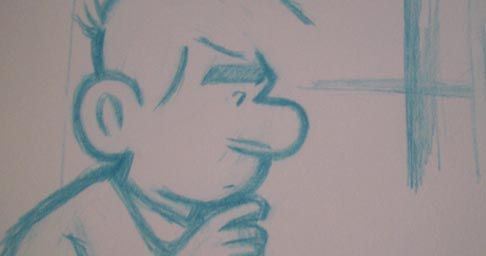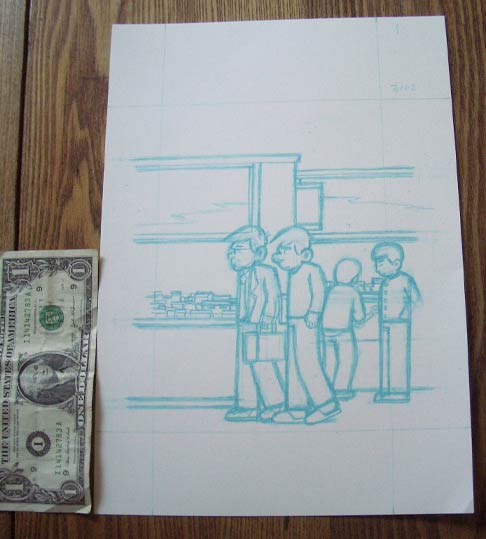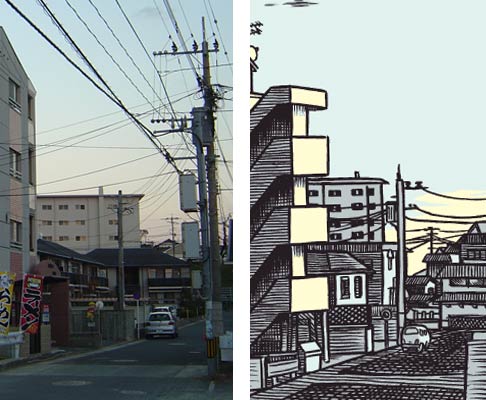
Pictured: A pencil sketch from work in progress Tonoharu: Part Two
After a very long, unscheduled delay, this is the seventh post in a series describing the creative process behind my graphic novel Tonoharu. This installment deals with my process for drawing the panels.
Up until now, the entries in this series have consisted of half-baked ruminations on vague subjects such as inspiration, writing, and design. From here on out, entries will be a more concrete, and deal with my actual process of creating the final artwork used in Tonoharu. Whether these entries will be of any interest to non-cartoonists I can’t say, but read on and find out.
I start off by drawing extremely simple thumbnail sketches for the scene I’ll be working on. I mean, really simple; almost unrecognizably so. But it’s important to draw thumbnails for the whole scene in advance, rather than just wing each panel as I go, for a couple reasons.
One is that it gives me an idea of where the characters should be situated in the panel relative to each other. Let’s say I have an eight panel scene, with two characters talking. Let’s say that Character A leads off the conversation in six of the panels, whereas Character B leads off the conversation in only two of the panels. Since we English speakers read from left to right, I’d put Character A to the left of Character B, so that Character A’s word bubbles appear first.
I also try to plot out each scene in advance in order to see if I can reuse the same backgrounds more than once, similar to what they do in cell-animated movies. When I first started out drawing Tonoharu, I drew each panel with its own background, even if the background was exactly the same from one panel to the next. I soon realized I would never finish the comic if I kept up like that, so I soon started reusing backgrounds and cutting corners in any way I could to try to save a little bit of time. It still takes forever, though.
When the thumbnail sketches are done, I start in on the actual artwork. I use 9″x12″ Bristol paper, which is the largest size paper that will fit on my scanner.
I draw each individual panel on its own sheet of paper. I do it this way so that I can draw each picture at larger than the final size (I draw it at 250%). Creating the original art at larger than final size is fairly standard practice among cartoonists, because when it’s reduced in size, the printed artwork looks smoother than when drawn at actual size.

One pencilled panel from Tonoharu: Part Two, with a dollar for scale
I make very extensive use of photo reference for Tonoharu; in particular for the backgrounds. I wanted the backgrounds in this comic to represent Japan as it is, and Japan settings are just too complicated to draw from memory. Whenever possible, I would go out and take pictures myself (thank god for digital cameras), because then I could get the exact bar/restaurant/street scene that I wanted. Since I’m now living in the US, I reply on internet image searches, along with photo reference books designed for cartoonists I got when I was in Japan. That sort of thing doesn’t exist in the US, but Japan’s comic culture is big enough to support that.

Pictured: The real world, and my inept attempt at reproducing it
*****
Although I’ve been drawing comics for like fifteen years now, none have been as detailed as Tonoharu, and I’ve learned a lot by doing it. It’s forced me to pay attention to a lot of things I’d otherwise never have given a second thought to. Things like typical Japanese streets, webs of power lines, teacher’s rooms, family restaurants, rundown bars, train stations, quaint cafes, rice fields…
And then all the things related to people: how do two female friends hug each other, and how is that different from a lovers’ embrace? How does an American man walk down the street, and how is it different from a Japanese woman? What does a girl’s hand look like when she uses it to tuck her hair behind her ear? How do people fold their legs when they’re tying their shoes, or hold a coffee cup when they’re drinking from it? Imaging these things offhandedly is one thing, but actually committing them to paper requires a more careful study of their nuance. I think doing all the drawing for this comic has had a lasting affect on my perspective of the world.
Okay, I guess that’s enough about that. Next time I’ll cover my process for inking the comic, as well as all the post-production computer work. Stay tuned.
Creating Tonoharu–#1: Laying The Groundwork
Creating Tonoharu–#2: The Idea
Creating Tonoharu #3–Writing the Script
Creating Tonoharu #4–The Design (1/3)
Creating Tonoharu #5–The Design (2/3)
Creating Tonoharu #6–The Design (3/3)
Creating Tonoharu #7–The Drawing
Creating Tonoharu #8–Inking
Creating Tonoharu #9–Computer Stuff
Creating Tonoharu #10–Final Edits

Pingback: jetwit.com - Tonoharu: Part Two–Progress Report #2()